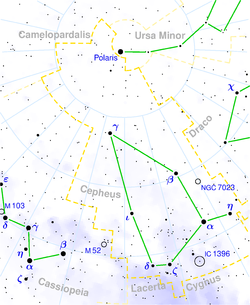- Delta Cephei
-
For the variable star type, see Delta Cephei variable.For the general type of variable star, see Cepheid variable.
Alrediph, δ Cep A/B Observation data
Epoch J2000.0 Equinox J2000.0Constellation Cepheus Right ascension 22h 29m 10.27s Declination +58° 24′ 54.7″ Apparent magnitude (V) 4.07 (3.48–4.37) / 7.5 Characteristics Spectral type F5 Iab (F5Ib-G2Ib) / B7 U−B color index 0.36 B−V color index 0.60 Variable type Cepheid Astrometry Radial velocity (Rv) -16.8 km/s Proper motion (μ) RA: 16.47±0.69 mas/yr
Dec.: 3.55±0.64 mas/yrParallax (π) 3.66 ± 0.15 mas Distance 891 ly
(273 pc)Absolute magnitude (MV) -3.47 Orbit Companion Delta Cephei B Period (P) 500 yr Semimajor axis (a) 12,000 AU Details Mass 5 / 4 M☉ Radius 41.6[1] R☉ Luminosity 2,000 / 500 L☉ Temperature 5,500–6,800 K Rotation ~9 km/s Age ~108 years Other designations Delta Cephei (δ Cep, δ Cephei) is a binary star system approximately 891 light-years away in the constellation of Cepheus (the King). Delta Cephei is the prototype of the Cepheid variable stars, and it is among the closest stars of this type to the Sun (with Polaris being closer). Its variability was discovered by John Goodricke in 1784, the second Cepheid variable discovered following Eta Aquilae earlier the same year.
Stellar system
Unlike the eclipsing binary Algol, Delta Cephei's variability is due to pulsation of the star. It varies from magnitude 3.48 to 4.37, and its spectral type also varies, from about F5 to G3. The period is 5.36634 days; rise to maximum is quicker than the subsequent decline to minimum. It was later discovered that there are two types of Cepheid variables, and Delta Cephei is now known as a type I (Classical) Cepheid.
Stars of this type are believed to form with masses of 3–30 times that of our Sun, and then have passed through the main sequence as B-class stars. With the hydrogen burnt up in their core, these unstable stars are now passing through later stages of nuclear burning.[2]
Knowing the distance of Delta Cephei and others in its class is fundamental to calibrating their period-luminosity relationship; unfortunately, these efforts were until recently marred by only fair parallax accuracy. In 2002 however, the Hubble Space Telescope was used to determine the distance to Delta Cephei (and RR Lyrae, another standard candle) within ~4%: 273 parsecs, or 890 light-years.[3] There is a 7.5 magnitude companion star, separated from Delta Cephei by 41 arc seconds and visible in small telescopes.
References
- ^ "Database of Galactic Classical Cepheids". David Dunlap Observatory. 1995. http://www.astro.utoronto.ca/DDO/research/cepheids/.
- ^ Turner, David G. (1998). "Monitoring the Evolution of Cepheid Variables". The Journal of the American Association of Variale Star Observers 26: 101. Bibcode 1998JAVSO..26..101T.
- ^ Benedict, G. Fritz; McArthur, B. E.; Fredrick, L. W.; Harrison, T. E.; Slesnick, C. L.; Rhee, J.; Patterson, R. J.; Skrutskie, M. F. et al. (2002). "Astrometry with the Hubble Space Telescope: A Parallax of the Fundamental Distance Calibrator δ Cephei". The Astronomical Journal 124 (3): 1695–1705. arXiv:astro-ph/0206214. Bibcode 2002AJ....124.1695B. doi:10.1086/342014.
External links
- "Delta Cephei". American Association of Variable Star Observers. 2000-09. Archived from the original on 2008-06-08. http://web.archive.org/web/20080608181511/http://www.aavso.org/vstar/vsots/0900.shtml. Retrieved 2008-06-21.
- "Delta Cephei". The Internet Encyclopedia of Science. http://www.daviddarling.info/encyclopedia/D/Delta_Cephei.html. Retrieved 2008-06-21.
- "Delta Cephei, 27 Cephei". SEDS. http://www.seds.org/~spider/spider/Vars/deltaCep.html. Retrieved 2008-06-21.
- Kaler, Jim. "Delta Cephei". University of Illinois. STARS. http://www.astro.uiuc.edu/~kaler/sow/deltacep.html. Retrieved 2008-06-21.
Bayer α (Alderamin) • β (Alfirk) • γ (Errai) • δ • ε • ζ • η • θ • ι • κ • λ • μ (Garnet Star) • ν • ξ (Kurhah) • ο • π • ρ¹ • ρ²Flamsteed 1 (κ) • 2 (θ) • 3 (η) • 4 • 5 (α, Alderamin) • 6 • 7 • 8 (β, Alfirk) • 9 • 10 (ν) • 11 • 12 • 13 • 14 • 15 • 16 • 17 (ξ, Kurhah) • 18 • 19 • 20 • 21 (ζ) • 22 (λ) • 23 (ε) • 24 • 25 • 26 • 27 (δ) • 28 (ρ¹) • 29 (ρ²) • 30 • 31 • 32 (ι) • 33 (π) • 34 (ο) • 35 (γ, Errai) • 2 UMi • 77 Dra • 78 DraNearby Kruger 60 • Gliese 809 • WISE 0313+7807 • Gliese 48 • GJ 1277Other List Categories:- Bayer objects
- Binary stars
- Cepheid variables
- Cepheus constellation
- G-type supergiants
- F-type supergiants
Wikimedia Foundation. 2010.

